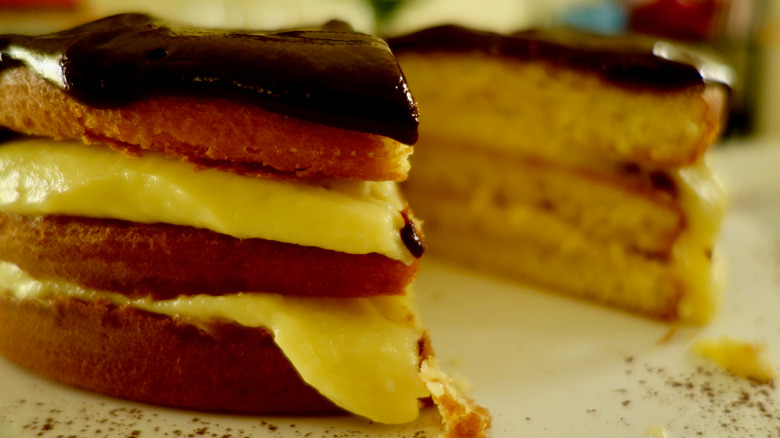Was Boston Cream Pie Actually Invented In Boston?
Was it the invention of a brand-new dessert or a tweak on an existing favorite? That's the question. The answer? It's not as clear. One thing is for sure, though. Boston's Omni Parker House, the oldest continuously operating hotel in the United States (via Omni Hotels), made Boston cream pie famous. Established in 1855, the Parker House, as it was known then, was the brainchild of Harvey D. Parker. A Maine native, Parker moved to Boston as a young adult with barely a penny to his name. He worked a number of jobs before establishing himself as a restaurateur and then opening the grand hotel, according to History of Massachusetts. The Parker House was the first hotel in the U.S. to adopt the "European plan," meaning guests paid for dining and lodging separately.
The European plan was a departure from the American plan (dining and lodging included at one price) more prevalent at the time. It paved the way for the hotel's dining room to become a destination in its own right, attracting in-house guests as well as locals interested in a fine-dining experience (via History of Massachusetts). And that's exactly what Parker had in mind when he enticed accomplished French chef M. Sanzian to the Parker House with the promise of a $5,000 annual salary — more than 10 times the average pay for similar positions at the time.
Chef Sanzian came out of the gate swinging, wowing patrons with a sophisticated menu, including the dessert he introduced in 1856, a two-layer French butter sponge cake filled with pastry cream and crowned with chocolate ganache. Sounds like a Boston cream pie to us.
Follow the evidence
Reports about exactly when Sanzian first served the now-iconic dessert vary. Omni Hotels, the current owner, asserts Sanzian created the dessert we know today as Boston cream pie for the hotel's grand opening gala. But, the hotel opened in 1855 and most accounts peg the dessert's debut to 1856, which still works if the gala took place sometime after the official opening (via History of Massachusetts).
The bigger debate is whether or not Sanzian created a brand-new dessert or just tweaked an old favorite. The question arises because, as The Food Historian notes, Sanzian's creation is undeniably similar to another dessert, Washington Pie, already popular at the time.
While suspected precursors to Boston cream pie feature layers and filling, none mention chocolate ganache. That may be Sanzian's personal touch. According to Atlas Obscura, Boston is the site of the first chocolate mill in the United States, so Bostonians were enjoying chocolate — usually drinking chocolate — while it was still difficult to find in other regions. Then there's the French connection. The custard filling in Boston cream pie is a variation of a French crème pâtissière (via Baking Like a Chef). French influence in an American dessert created by a French chef. Food for thought.
Based on mounting evidence, we think it's safe to say Sanzian created Boston cream pie by putting his own twist on layer cake with filling. Why is the dessert that clearly looks like a cake known far and wide as a pie? That's a discussion for another day.

